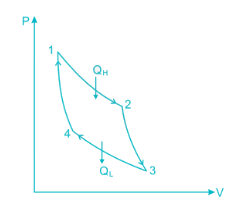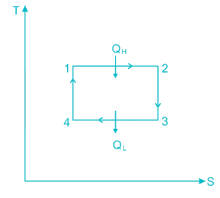Mechanical Engineering Exam > Mechanical Engineering Questions > Carnot cycle consists ofa)Two constant volume...
Start Learning for Free
Carnot cycle consists of
- a)Two constant volume and two isentropic processes
- b)Two isothermal and two isentropic processes
- c)Two constant pressure and two isentropic processes
- d)One constant volume, one constant pressure and two isentropic processes
Correct answer is option 'B'. Can you explain this answer?
| FREE This question is part of | Download PDF Attempt this Test |
Verified Answer
Carnot cycle consists ofa)Two constant volume and two isentropic proce...
Carnot cycle is one of the best-known reversible cycles. The Carnot cycle is composed of four reversible processes.
- Reversible Isothermal Expansion (process 1-2)
- Reversible adiabatic expansion (process 2-3)
- Reversible isothermal compression (process 3-4)
- Reversible adiabatic compression (process 4-1)

 Fig. P-V and T-S diagrams of Carnot Cycle
Fig. P-V and T-S diagrams of Carnot Cycle
Most Upvoted Answer
Carnot cycle consists ofa)Two constant volume and two isentropic proce...
Carnot cycle consists of Four Processes
The Carnot cycle is a theoretical thermodynamic cycle that consists of four processes. These are:
1. Isothermal expansion: The gas is expanded slowly and isothermally, i.e., at constant temperature, by allowing it to do work on a piston.
2. Adiabatic expansion: The gas is further expanded adiabatically, i.e., without any heat exchange with its surroundings, again by doing work on a piston.
3. Isothermal compression: The gas is compressed isothermally, i.e., at constant temperature, by doing work on it.
4. Adiabatic compression: The gas is further compressed adiabatically, i.e., without any heat exchange with its surroundings, by doing work on it.
Carnot cycle consists of two isothermal and two isentropic processes
The Carnot cycle consists of two isothermal and two adiabatic processes. The isothermal processes are processes 1 and 3, where the temperature of the gas is kept constant. The adiabatic processes are processes 2 and 4, where there is no heat exchange with the surroundings.
The cycle is reversible and the efficiency is maximum
The Carnot cycle is a reversible cycle, i.e., it can be run in reverse to extract work from a heat source. The cycle is also the most efficient possible cycle operating between two given temperatures. The efficiency of the Carnot cycle is given by the formula:
Efficiency = (T1-T2)/T1
where T1 is the higher temperature and T2 is the lower temperature of the cycle.
Conclusion
The Carnot cycle consists of two isothermal and two adiabatic processes. It is a reversible cycle and the most efficient possible cycle operating between two given temperatures. The efficiency of the cycle is given by the formula: Efficiency = (T1-T2)/T1.
The Carnot cycle is a theoretical thermodynamic cycle that consists of four processes. These are:
1. Isothermal expansion: The gas is expanded slowly and isothermally, i.e., at constant temperature, by allowing it to do work on a piston.
2. Adiabatic expansion: The gas is further expanded adiabatically, i.e., without any heat exchange with its surroundings, again by doing work on a piston.
3. Isothermal compression: The gas is compressed isothermally, i.e., at constant temperature, by doing work on it.
4. Adiabatic compression: The gas is further compressed adiabatically, i.e., without any heat exchange with its surroundings, by doing work on it.
Carnot cycle consists of two isothermal and two isentropic processes
The Carnot cycle consists of two isothermal and two adiabatic processes. The isothermal processes are processes 1 and 3, where the temperature of the gas is kept constant. The adiabatic processes are processes 2 and 4, where there is no heat exchange with the surroundings.
The cycle is reversible and the efficiency is maximum
The Carnot cycle is a reversible cycle, i.e., it can be run in reverse to extract work from a heat source. The cycle is also the most efficient possible cycle operating between two given temperatures. The efficiency of the Carnot cycle is given by the formula:
Efficiency = (T1-T2)/T1
where T1 is the higher temperature and T2 is the lower temperature of the cycle.
Conclusion
The Carnot cycle consists of two isothermal and two adiabatic processes. It is a reversible cycle and the most efficient possible cycle operating between two given temperatures. The efficiency of the cycle is given by the formula: Efficiency = (T1-T2)/T1.
Attention Mechanical Engineering Students!
To make sure you are not studying endlessly, EduRev has designed Mechanical Engineering study material, with Structured Courses, Videos, & Test Series. Plus get personalized analysis, doubt solving and improvement plans to achieve a great score in Mechanical Engineering.

|
Explore Courses for Mechanical Engineering exam
|

|
Similar Mechanical Engineering Doubts
Carnot cycle consists ofa)Two constant volume and two isentropic processesb)Two isothermal and two isentropic processesc)Two constant pressure and two isentropic processesd)One constant volume, one constant pressure and two isentropic processesCorrect answer is option 'B'. Can you explain this answer?
Question Description
Carnot cycle consists ofa)Two constant volume and two isentropic processesb)Two isothermal and two isentropic processesc)Two constant pressure and two isentropic processesd)One constant volume, one constant pressure and two isentropic processesCorrect answer is option 'B'. Can you explain this answer? for Mechanical Engineering 2024 is part of Mechanical Engineering preparation. The Question and answers have been prepared according to the Mechanical Engineering exam syllabus. Information about Carnot cycle consists ofa)Two constant volume and two isentropic processesb)Two isothermal and two isentropic processesc)Two constant pressure and two isentropic processesd)One constant volume, one constant pressure and two isentropic processesCorrect answer is option 'B'. Can you explain this answer? covers all topics & solutions for Mechanical Engineering 2024 Exam. Find important definitions, questions, meanings, examples, exercises and tests below for Carnot cycle consists ofa)Two constant volume and two isentropic processesb)Two isothermal and two isentropic processesc)Two constant pressure and two isentropic processesd)One constant volume, one constant pressure and two isentropic processesCorrect answer is option 'B'. Can you explain this answer?.
Carnot cycle consists ofa)Two constant volume and two isentropic processesb)Two isothermal and two isentropic processesc)Two constant pressure and two isentropic processesd)One constant volume, one constant pressure and two isentropic processesCorrect answer is option 'B'. Can you explain this answer? for Mechanical Engineering 2024 is part of Mechanical Engineering preparation. The Question and answers have been prepared according to the Mechanical Engineering exam syllabus. Information about Carnot cycle consists ofa)Two constant volume and two isentropic processesb)Two isothermal and two isentropic processesc)Two constant pressure and two isentropic processesd)One constant volume, one constant pressure and two isentropic processesCorrect answer is option 'B'. Can you explain this answer? covers all topics & solutions for Mechanical Engineering 2024 Exam. Find important definitions, questions, meanings, examples, exercises and tests below for Carnot cycle consists ofa)Two constant volume and two isentropic processesb)Two isothermal and two isentropic processesc)Two constant pressure and two isentropic processesd)One constant volume, one constant pressure and two isentropic processesCorrect answer is option 'B'. Can you explain this answer?.
Solutions for Carnot cycle consists ofa)Two constant volume and two isentropic processesb)Two isothermal and two isentropic processesc)Two constant pressure and two isentropic processesd)One constant volume, one constant pressure and two isentropic processesCorrect answer is option 'B'. Can you explain this answer? in English & in Hindi are available as part of our courses for Mechanical Engineering.
Download more important topics, notes, lectures and mock test series for Mechanical Engineering Exam by signing up for free.
Here you can find the meaning of Carnot cycle consists ofa)Two constant volume and two isentropic processesb)Two isothermal and two isentropic processesc)Two constant pressure and two isentropic processesd)One constant volume, one constant pressure and two isentropic processesCorrect answer is option 'B'. Can you explain this answer? defined & explained in the simplest way possible. Besides giving the explanation of
Carnot cycle consists ofa)Two constant volume and two isentropic processesb)Two isothermal and two isentropic processesc)Two constant pressure and two isentropic processesd)One constant volume, one constant pressure and two isentropic processesCorrect answer is option 'B'. Can you explain this answer?, a detailed solution for Carnot cycle consists ofa)Two constant volume and two isentropic processesb)Two isothermal and two isentropic processesc)Two constant pressure and two isentropic processesd)One constant volume, one constant pressure and two isentropic processesCorrect answer is option 'B'. Can you explain this answer? has been provided alongside types of Carnot cycle consists ofa)Two constant volume and two isentropic processesb)Two isothermal and two isentropic processesc)Two constant pressure and two isentropic processesd)One constant volume, one constant pressure and two isentropic processesCorrect answer is option 'B'. Can you explain this answer? theory, EduRev gives you an
ample number of questions to practice Carnot cycle consists ofa)Two constant volume and two isentropic processesb)Two isothermal and two isentropic processesc)Two constant pressure and two isentropic processesd)One constant volume, one constant pressure and two isentropic processesCorrect answer is option 'B'. Can you explain this answer? tests, examples and also practice Mechanical Engineering tests.

|
Explore Courses for Mechanical Engineering exam
|

|
Suggested Free Tests
Signup for Free!
Signup to see your scores go up within 7 days! Learn & Practice with 1000+ FREE Notes, Videos & Tests.
























